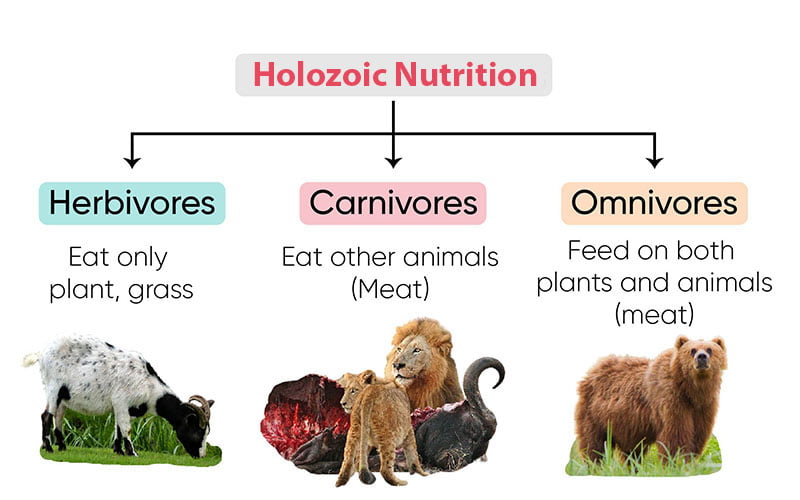
Holozoic nutrition is an essential biological process that plays a pivotal role in the survival and growth of higher organisms, enabling them to derive nutrients from complex food sources. From carnivores to omnivores and herbivores, the spectrum of holozoic feeders is vast and encompasses a wide range of organisms. Here we discuss a detailed exploration of holozoic nutritions, its significance, mechanisms, and the diverse adaptations exhibited by various species.
At its core, holozoic nutrition refers to the method of acquiring nutrients by ingesting complex organic matter, such as plants or other animals, and subsequently digesting and assimilating those nutrients within the body. This process involves several stages, including ingestion, digestion, absorption, and assimilation. It is prominently observed in higher organisms like animals, where specialized structures and systems facilitate the efficient breakdown and utilization of food.
It is widely prevalent in the animal kingdom, with various species exhibiting unique feeding strategies tailored to their ecological niches. Let’s explore some of the fascinating examples of holozoic nutrition in different animals:
Carnivores are skilled predators that primarily feed on the flesh of other animals. Their holozoic nutrition revolves around consuming meat, which provides them with essential nutrients, particularly proteins and fats. The structure of their teeth and jaws is adapted for tearing and devouring flesh, showcasing the specialization required for their dietary preferences.
Herbivores are creatures that thrive on plant-based diets. Their digestive systems are adept at breaking down tough plant material to access the nutrients enclosed within. Holozoic nutritions in herbivores involves fermentation processes in specialized chambers like the rumen (present in ruminants) to facilitate the breakdown of cellulose and other complex plant compounds.
Omnivores are incredibly adaptable and consume both plant and animal matter. Their holozoic nutrition allows them to switch between food sources based on availability and nutritional requirements. Their dentition often reflects a mix of carnivorous and herbivorous characteristics, enabling them to consume a diverse array of foods.
Humans, being omnivores, have a versatile holozoic nutritional strategy. Our ability to digest both plant and animal matter has been instrumental in our survival and evolution as a species. The human digestive system comprises several organs, each with a specific role in processing and absorbing nutrients.
The process of holozoic nutrition in humans begins with the ingestion of food, where the oral cavity, equipped with teeth and salivary glands, plays a crucial role in breaking down the food into smaller, more manageable pieces. Enzymes in saliva begin the initial digestion of carbohydrates.
Once food passes through the esophagus, it enters the stomach, where gastric juices containing hydrochloric acid and pepsin aid in the breakdown of proteins. The resulting mixture, known as chyme, moves into the small intestine, where further digestion occurs, facilitated by pancreatic enzymes and bile secreted by the liver.
In the small intestine, nutrients are absorbed through the intestinal walls into the bloodstream, providing the body with essential sustenance. The indigestible parts of the food, along with waste products, move into the large intestine, where water absorption takes place, leading to the formation of feces.
A: Holozoic nutritions involves the ingestion of complex organic matter and the internal breakdown and assimilation of nutrients. In contrast, other forms of nutrition, such as saprophytic nutrition, involve absorbing nutrients from decaying organic matter, and autotrophic nutrition involves synthesizing nutrients from inorganic sources using sunlight.
A: Holozoic nutritions is characteristic of animals and involves consuming other living or dead organisms for sustenance. On the other hand, holophytic nutrition, also known as photosynthetic nutrition, is unique to plants, where they use sunlight to synthesize their food.
A: Yes, the African lion exemplifies specialized holozoic nutritions. Being carnivores, they possess sharp teeth and powerful jaws, well-suited for hunting and consuming prey.
A: Humans lacks specialized adaptations. Our omnivorous nature allows us to adapt to various dietary options. Additionally we humans hold the ability to process and consume a wide range of foods.
A: Holozoic nutrition is crucial for higher organisms as it provides them with a diverse array of nutrients necessary for growth, development, and maintenance of bodily functions. This nutrition strategy allows for a higher level of energy utilization and supports the complexity of physiological processes in advanced organisms.
A: Holozoic nutritions and the interplay between various feeding strategies among species contribute to the balance and functioning of ecosystems. The predator-prey relationships, as observed in holozoic nutrition, play a vital role in regulating populations and maintaining biodiversity.
Holozoic nutrition is a remarkable phenomenon that underpins the existence and functioning of higher organisms in the natural world. Creatures like carnivorous predators, herbivores, and the omnivores like humans, all holozoic feeders showcases the incredible diversity of life on Earth. It provides us with profound insights into the delicately balanced relationships between organisms and their ecosystems. Holozoic nutrition remains a topic of perpetual fascination and a testament to the marvels of evolution.
Recommended other topics: Achieve Medical Weightloss-Your Path to a Healthier You










© InfoDoot. All Rights Reserved.